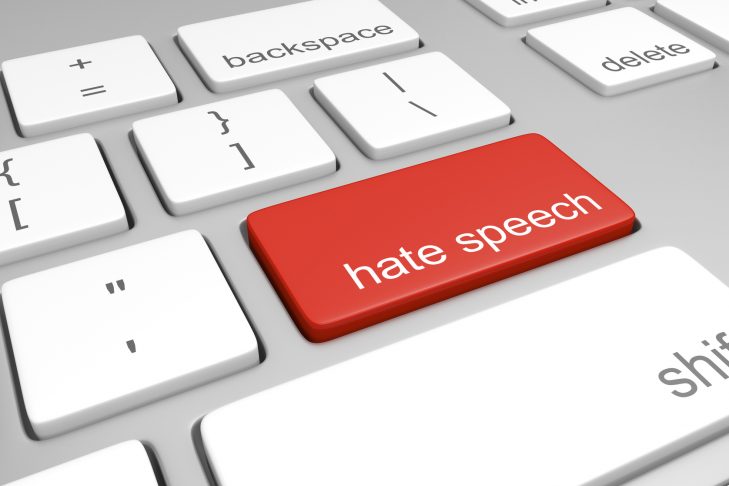It has been almost three decades since I monitored right-wing extremists for the Anti-Defamation League (ADL). Aside from alarming people at parties with my comprehensive knowledge of Klan cells and neo-Nazi gangs, the job exposed me to a level of raw, virulent hate I had never seen before. And the experience has stayed with me.
In those pre-Internet days, everything from sophisticated glossy magazines dressed up as pseudo-academic articles to mimeographed hate-sheets crossed my desk. I scanned for names, looked for trends. Sometimes I was amused in the sense that the stuff couldn’t be real. But mostly I was shocked that there were people out there who were obsessed with Nazism and white supremacy.
Over the years, I have kept an eye out for newspaper stories related to my old beat, occasionally recognizing a name. By now, though, the old guard has died off and purveying hate has reached a broader audience with the advent of the Internet. To address the spread of extremism, my former employer created a database in October 2000 aptly named “Hate on Display.” The project began with collecting old chestnuts like swastikas and the number 88, which represents Heil Hitler, and went on to track racist hand signs, acronyms and other sundry hate symbols.
Last month the ADL added a new symbol to its database, called the “echo.” The echo is a departure from its hateful cousins in that it is the first officially recognized symbol from the “alt-right”—a 2.0 version of the supremacists that I followed in the ‘80s and ‘90s. These new extremists are as equally obsessed with hate as they are with imagery and memes. The echo is used online to call attention to Jews. Here’s how it works: Jewish names that make the news or are media bylines are nested between three sets of parentheses. This is what it looks like: (((Jewish Name))). The echo symbol originated in an anti-Semitic podcast called “Daily Shoah” in 2014. The goal was to highlight names of people perceived as Jewish to harass them both online and offline.
Robert Trestan, director of the ADL’s Boston office, explains that the echo is different from other symbols in the organization’s database. “The sole intent here is to identify Jews,” he said in a telephone interview. “The message is: If your name is between those marks, you’re Jewish. It tells the people in a [white supremacist community] that it’s OK to target that person. That’s what makes this a little more unique, more dangerous.”
Things have gotten more complicated in 2016 with Donald Trump as the presumptive Republican presidential nominee. As JewishBoston’s culture reporter, I deliberately sidestep politics. But I cannot mention the echo without noting that much of its anti-Semitism has come from self-identified Trump supporters. And Trump himself has been eerily silent about the situation.
Last month, Jonathan Weisman, The New York Times’ Washington bureau chief, and Jeffrey Goldberg of The Atlantic were among those who found their names between parentheses. In an article Weisman published in The Times’ Sunday Review, he pointed out that after he had tweeted an essay about the emergence of fascism, “…I found myself staring down a social-media timeline filled with raw hate and anti-Semitic tropes that for centuries fueled expulsion, persecution, pogroms and finally genocide.” By the end of that virtual timeline Weisman had been “echoed.”
In the past couple of weeks a number of Jewish users on Twitter have turned the tables on the haters and co-opted the echo symbol. They have nested their own names in between parentheses in solidarity with those who have been targeted by the alt-right. One such target was Ella Nilsen, a young reporter with the Concord Monitor in New Hampshire. Nilsen found her name and picture on a Twitter list of mostly Jewish politicians and journalists. The list was called “The Train Depot” and the caption underneath said, “These (((people))) awaiting Disinfection and Bath before entering the Main Camp.”
Nilsen, who claims some Jewish ancestry but does not identify as Jewish, was confused as to why she was targeted. In an article she wrote for her newspaper on the incident, she said:
“What disturbs me is how freely hate speech is flowing these days. As a young American I’m afraid of the prospect of these people around me becoming desensitized to it. What disturbs me is that the new standard-bearer of the Republican Party has not yet disavowed his neo-Nazi supporters.”
I recognize Nilsen’s shock and anguish. Despite this latest anti-Semitic meme, Jonathan Greenblatt, ADL’s CEO, reports that “our polling suggests that anti-Semitic attitudes in America are largely in decline—it shows how those on the fringes are using and abusing social media to mainstream anti-Semitic notions, themes and stereotypes.”
So little in the extremist movement seems to have changed since I worked for the ADL. Sometimes, I fear we are regressing.



